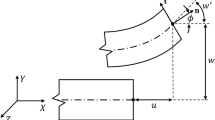Abstract
Line-spring model was used for the simplified analysis of dynamic stress-intensity factor for part-through surface crack. Methods were presented for both evaluation of dynamic compliance of the line-spring and of dynamic stress-intensity factor along the crack front. It was found that the value of the dynamic compliance coefficient of the line-spring does not vary with the frequency of applied load and is good agreement with the analytical result given by Rice and Levy under static load conditions. To verify the validity of the present model, the dynamic stress-intensity factors were calculated for edge cracked strips in plane strain. The results obtained from the present model coincide with those obtained from the finite element analysis using quarter-point singularity elements around the crack tip. As an example of the application of the present model, the dynamic response of a plate containing a semi-elliptical surface crack was analysed where the plate is subjected to a vibrating stress at its ends.
Similar content being viewed by others
References
Barsoum, R. S. (1977): Tritangular quarter-point elements as elastic and perfectly-plastic crack tip elements. Int. J. Numer. Meth. Eng. 11, 85–98
Brown, W. F., Jr.; Srawley, J. E. (1966): Plane strain crack toughness testing of high strength metallic materials. ASTM STP-410
Mindlin, R. D. (1951): Influence of rotatory inertia and shear on flexural motions of isotropic, elastic plates. J. Appl. Mech. 18, 31–38
Raju, I. S.; Newman, J. C., Jr. (1979): Stress-intensity factors for a wide range of semi-elliptical surface cracks in finite-thickness plates. Eng. Fract. Mech. 11, 817–829
Rice, J. R.; Levy, N. (1972): The part-through surface crack in an elastic plate. J. Appl. Mech. 39, 185–194
Saka, M.; Akamatsu, M.; Abé, H. (1987): Dynamic line-spring model for the analysis of dynamic response of part-through surface cracks. In: Sih et al. (eds.): Proc. Int. Conf. Role of Fracture Mechanics in Modern Technology, Fukuoka, June, 1986, pp. 529–540. Amsterdam: North-Holland
Author information
Authors and Affiliations
Rights and permissions
About this article
Cite this article
Hua, T.D., Abé, H. A simplified analysis of the dynamic stress-intensity factors for the part-through surface crack in an elastic plate. Computational Mechanics 5, 469–478 (1990). https://doi.org/10.1007/BF01113450
Issue Date:
DOI: https://doi.org/10.1007/BF01113450




